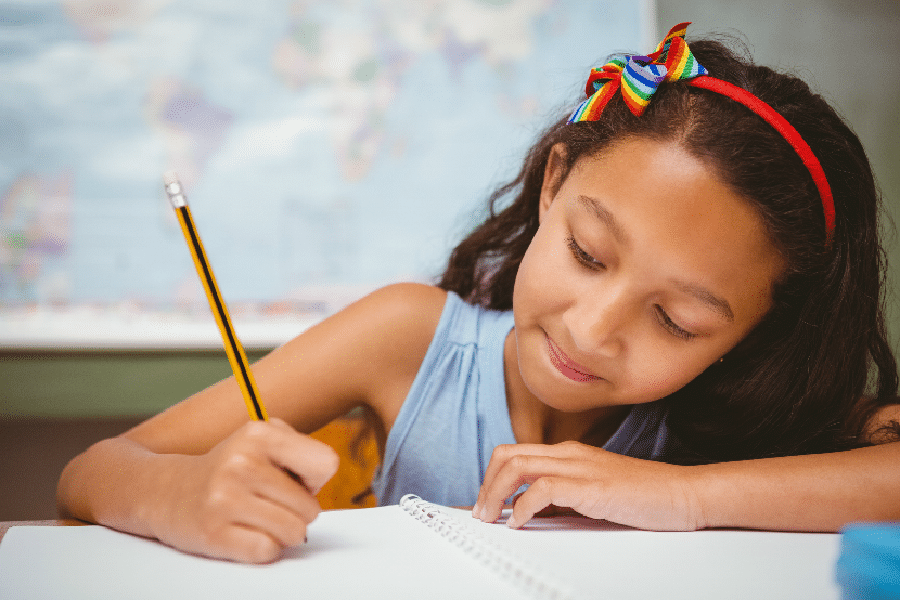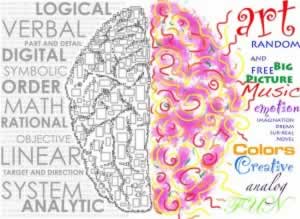Understanding how dyslexic students learn and teaching with corresponding methods will make a big impact on learning.

We’re just about midway through the school year. All of the fun of planning and purchasing of curriculum (why is that so fun?) has passed and we’ve been feeding off of a steady diet of stark reality. Homeschooling is hard. Homeschooling with dyslexia is even harder.
If you were raised and educated in a traditional school setting as I was, our default method for teaching our kids, despite the enormous amount of freedom that we have as homeschoolers, is to teach how we were taught. The trouble with this is that most teachers and text books teach with a method that does not work well with dyslexic learners.
So what methods do work with dyslexic learners?
Right Brains and Left Brains

Most dyslexic learners are right-brain dominant. To understand this you need to know a little bit about brain structure.
The brain is made up of two halves or hemispheres – the right brain and the left brain. These are connected to each other by a thick cable of nerves at the base of each brain called the corpus collosum. A good analogy is that of two separate, incredibly fast and immensely powerful computers, each running different programs from the same input, connected by a network cable.
Most scientists agree that there are definite differences in the way each hemisphere of the brain works. Essentially, the right brain deals with emotions, feelings, creativity, and intuition. The left brain is linear, logical, and focuses on one thing at a time.
| LEFT BRAIN FUNCTIONS | RIGHT BRAIN FUNCTIONS |
| uses logic | uses feeling |
| detail oriented | “big picture” oriented |
| verbal | non verbal |
| facts rule | imagination rules |
| words & language | symbols & images |
| math & science | philosophy & religion |
| order/pattern perception | spatial perception |
| knows object name | knows object function |
| reality based | fantasy based |
| forms strategies | presents possibilities |
| practical | impetuous |
| safe | risk taking |
Think back to the methods that your school used, or that you may be using with your kids. Read the text, understand, answer the questions. If you were a left-brained student like me, you loved this (and may have become a teacher or curriculum writer). Just tell me how many pages to do, ma’am! If you were a right-brained student, you likely struggled to learn and got out of school as fast as possible!
Right Brain Teaching Techniques
For a teaching method to work with a right-brained learner, it helps if those methods tap into the right-brained thinker’s natural strengths:
- Use visual resources such as whiteboard or chalkboard
- Doing subjects together in a group with lots of discussions
- In lieu of writing a paper, let students create a project (poster, comic strip, write a movie review instead of a report, etc)
- Play music during study time
- Use color and pictures on flash cards to get spelling or vocabulary words to stick
Understanding Learning Styles
Learning style is a broad term used to describe the factors that influence all aspects of learning. You may have heard the common, simplified view of learning styles as a choice of either the auditory, visual or kinesthetic pathway. While all people use every one of these pathways for learning; most people prefer one over the other. There are many factors that affect a person’s ability to learn.
Knowing the learning style of your student is important in determining how to teach them so they learn. To learn more about learning styles, read this post from my 10-part series on Homeschooling With Dyslexia: Understanding Learning Styles.
That’s All Great But How Do You Teach Math?
I’m glad that you asked.
In this series, I’ll be tackling each subject that we teach and share how we teach them in our houseful of dyslexics.
Teaching kids with dyslexia doesn’t need to be fraught with frustration once parents realize how dyslexics learn and apply those methods in a positive environment.

Never miss a post!
Subscribe to get our latest content by email.







can you please advise me on how to help my son with reading.
barton reading program….
Hello.
I am going to pull my children out of the public school. My 13 year old daughter is severly dyslexic, irlen syndrom and I believe dyscalculia. I am looking for tools to help her gain knowledge as she is struggling severly in all subject matter. I am a single mom looking for help. Any information would be appreciated.
Sincerley
Judith
Hi Judith. You’ve come to the right place. The site is full of info and articles on how to teach our kids. She’ll be okay. One day at a time!
Judith, I hope you get your daughter the glasses for the Irlen Syndrome, they help immensely, I know they’re expensive, but worth it. I have it, my mother has it, my brother & my son have it severely. The irlen glasses are awesome.
As a child who grew up in the public school system back in the mid 1960’s through the 1970’s & who is both dyslexic & dysgraphia school was never my thing. Having a teacher that could see both my strengths/struggles & successes/failures & still look outside the box in teaching was very few. God blessed me with a mom with the desire to teach & saw her child sinking fast, she knew I needed help & fast & did her best to see I got what I needed. God bless ALL who teach children with learning disabilities weather it is in a homeschool, private or public school environments. NEVER GIVE UP on those “Gifted” children & tell them to NEVER STOP BELIEVING THEY ARE AWESOME!
I’m 41 years old and I have dyslexia, I love the arts and music but I also love math and science because it makes sense in my head I may use my right hand to write but for everything else I use left and do everything as if I was left handed. I can say have of the stuff in this post makes know sense.